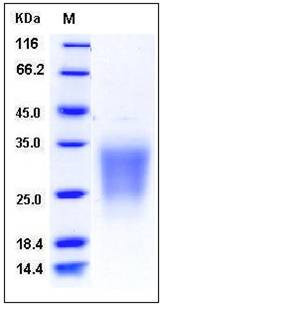Human SIGIRR / TIR8 Protein (His Tag)
TIR8
- 100ug (NPP4269) Please inquiry
| Catalog Number | P12165-H08H |
|---|---|
| Organism Species | Human |
| Host | Human Cells |
| Synonyms | TIR8 |
| Molecular Weight | The recombinant human SIGIRR consists of 129 amino acids and has a predicted molecular mass of 14 kDa. In SDS-PAGE under reducing conditions, the apparent molecular mass of rhSIGIRR is approximately 25-35 kDa due to glycosylation. |
| predicted N | Met 1 |
| SDS-PAGE |  |
| Purity | > 95 % as determined by SDS-PAGE |
| Protein Construction | A DNA sequence encoding the human SIGIRR (Q6IA17-1) extracellular domain (Met 1-His 118) was expressed, fused with a polyhistidine tag at the C-terminus and a signal peptide at the N-terminus. |
| Bio-activity | |
| Research Area | Developmental Biology |Post embryonic development |Cellular Senescence & Aging |Apoptosis |NF-kB (NFkB) Pathway |
| Formulation | Lyophilized from sterile PBS, pH 7.4 1. Normally 5 % - 8 % trehalose and mannitol are added as protectants before lyophilization. Specific concentrations are included in the hardcopy of COA. |
| Background | Single Ig IL-1-related receptor (SIGIRR) or TIR8 is a member of Toll-like receptor-interleukin 1 receptor signaling (TLR-IL-1R) receptor superfamily. Although SIGIRR/TIR8 shows the typical conserved motifs that characterize the IL-1R and Toll superfamily, it is structurally and functionally distinct from both. SIGIRR/TIR8 has only one Ig domain in its extracellular portion whereas the IL-1R family contains three Ig folds. An unusually long cytoplasmic domain is reminiscent of the structure of drosophila Toll, yet the SIGIRR peptide sequence is more closely related to IL-1RI. SIGIRR/TIR8 was mainly expressed in mouse and human epithelial tissues such as kidney, lung and gut. Resting and activated T and B lymphocytes and monocytes-macrophages expressed little or no SIGIRR/TIR8, with the exception of the mouse GG2EE macrophage line. Inflammation is enhanced in SIGIRR-deficient mice. SIGIRR negatively modulates immune responses. Inflammation is enhanced in SIGIRR-deficient mice, as shown by their enhanced chemokine induction after IL-1 injection and reduced threshold for lethal endotoxin challenge. |
| Reference |
